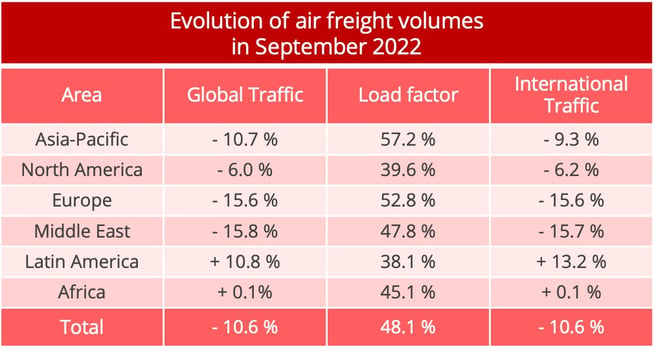
Global air freight traffic fell 10.6% year on year in September 2022, causing a corresponding reduction in freight rates.
The September figures published by the International Air Transport Association (IATA) confirm that the slowdown in air freight activity is continuing. Global air freight volumes were down 10.6% on their September 2021 total at 20.33 billion tonne-kilometres overall and 10.6% down, too, in the purely international sector. Certainly, the reference total was high, since the second half of 2021 was marked by particularly dynamic growth, as economies played catch-up after the Covid-19 pandemic. But the reduction in volumes is nevertheless indicative of a market slowdown. In September 2022, demand was 3.6% below its September 2019 level, while seasonally corrected data showed that September volumes were 1.5% down on those recoded in August.

* CTK : cargo tonne-kilometres – Data source : IATA.
Demand down on major markets
As in August, only the Latin American and African companies registered an increase in volumes over the previous year, but they only account for a very small share of the global market.
The Asian companies, which lead the market with a 32.6% share of global traffic, experienced a new fall in demand, which dropped 10.7% year on year, compared with 8.3% in August. The trend was similar among American companies, which saw demand fall 6% in September, compared to 3.4% in August.
The consequences of the war in Ukraine continued to weigh on the activity of European companies but also, increasingly, on that of Middle Eastern carriers.
Freight rate erosion
The airlines seem to have opted for vigilance in the face of the market slowdown. They are continuing to bring capacity back into service but the process has slowed markedly. In September 2022, capacity was 2.4% up on September 2021 and 5% up in the international sector alone. It was nevertheless still 7.4% down on its September 2019 level and 8.1% down in the international sector. IATA director general Willie Walsh said that the "strategic slow-down in capacity growth from 6.3% in August to 2.4% in September demonstrates the flexibility the industry has in adjusting to economic developments." The load factor settled at 48.1%, compared to 50.7% in September 2021, while, in the international sector, it fell from 56.8% to 53.4%.
Upply's database, which takes account of spot and contract prices, reflects the slowdown. Freight rates nevertheless remained solid in relation to their pre-pandemic levels. The market's change of direction seems for the time being to have been less violent than in the shipping industry.

Source : Upply
Economic indicators still unfavourable
For the IATA director general, the sector's somewhat morose results are nevertheless satisfying, taking account of the "headwinds" it is facing.
Willie Walsh noted, firstly, that consumers' habits have changed by comparison with the pandemic period. Consumers are turning back to services like restaurants and leisure activities at the expense of online purchases of goods, which soared during the lockdowns. At the same time, high inflations levels and fears of a recession are also encouraging people to be cautious.
The economic pessimism can also be seen in the Purchasing Managers' Index for new export orders. It fell back for the third consecutive month - and even for a seventh consecutive month in Germany - to reach its lowest level in two years.
Despite some positive indications like the slowdown in the rise of production costs and the stability of oil prices in September, it seems clear that, this year, the air freight sector will not be able to enjoy a remake of the flamboyant peak season of 2021.
Our latest articles
-
5 min 16/01/2026Lire l'article
-
Subscriber Ocean freight rates take on fresh colours in December
Lire l'article -
Our three scenarios for container shipping in 2026
Lire l'article



